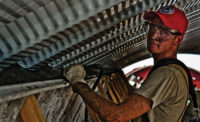There are no standards in place to govern how data gleaned from wearables is used and protected, but, according to Lydia Baugh, director of external affairs at the International Safety Equipment Association (ISEA), that might be about to change.
At its next annual meeting in November, the ISEA plans to start having discussions with its members about developing privacy and use standards — or at least guidance — for the data collected from wearables, how workers can view this information and in what ways the data can be analyzed to predict trends and patterns so as to better assist workers.
The scope of a potential new standard is up in the air right now, but Michelle Schaap, an attorney with Chiesa Shahinian & Giantomasi PC, identified several areas of concern that ISEA might want to include in its discussions:
- If the wearable includes some kind of alert with the purpose of getting the employee to stop work, then what if the employee continues to work?
- Who else gets the alert — an onsite supervisor?
- Will employees’ responses to alerts and other data be a part of performance reviews?
- What if the wearable or wearable app is hijacked, and the worker’s data is accessed or altered?
- Will the data from the wearables be a required disclosure as part of future project proposals to prove how the company monitors safety on the job?
- Will the information be used to decide whether to retain workers?
A wearable technology standards in general, said Anthony Colonna, Skanska USA’s senior vice president of innovative construction solutions, could make workers more comfortable with using the devices.
“When standards are developed that anonymize data to address those privacy concerns,” he said, “I believe people will become more receptive. At the same time, if employees can truly trust that there’s a personal value added by sharing certain data — like when it improves their personal health and safety, for example — then they will likely be more than willing to share their personal information.”
Standard development could take three years
Baugh said that ISEA plans on soliciting input from various industry stakeholders and that the development of a broad standard for connected workers likely will take up to three years.
“Technology and wearables,” Schaap said, “can certainly enhance safety and, hopefully, eliminate catastrophic injuries by ensuring that workers stay alert or are removed from operating equipment or being on site at all if they are not suited to work.
"However," she added, "the potential for abuse, misuse and compromise cannot be ignored, and any company that adopts these 'tools' — as with any new piece of equipment — must consider all of the value-adds and the potential risks before implementing these new technologies.”
Source: constructiondive.com



